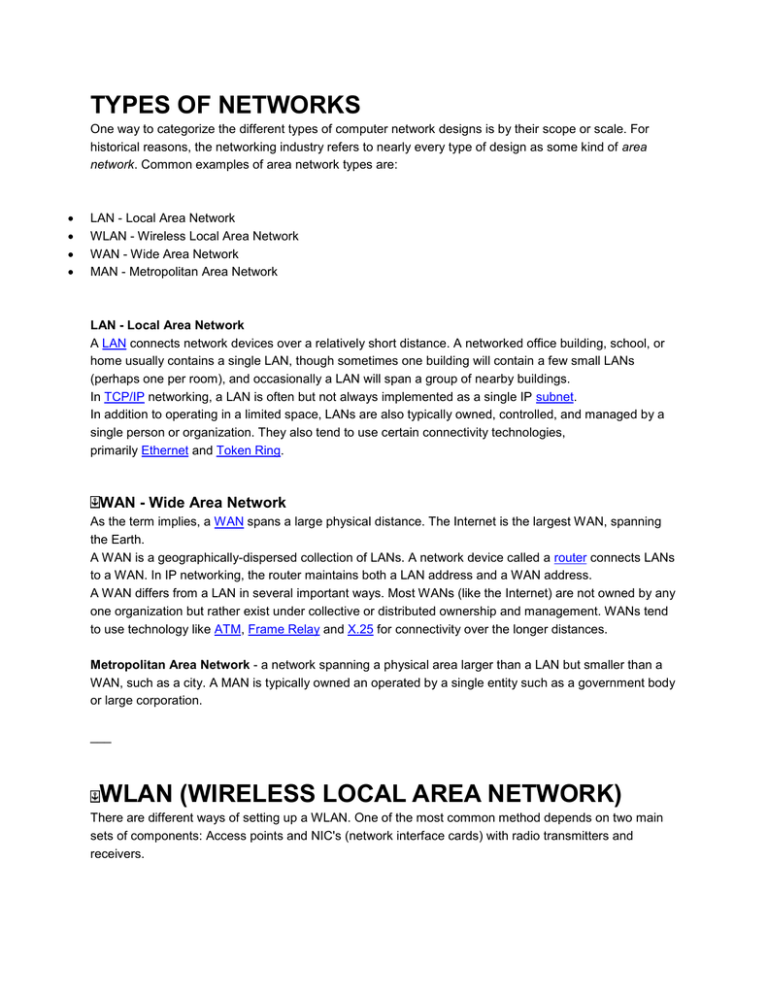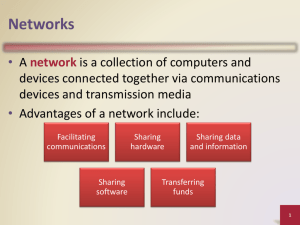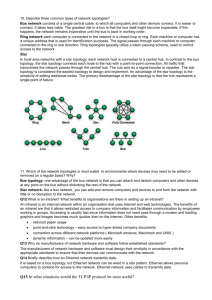form 3 (1)
advertisement

TYPES OF NETWORKS One way to categorize the different types of computer network designs is by their scope or scale. For historical reasons, the networking industry refers to nearly every type of design as some kind of area network. Common examples of area network types are: LAN - Local Area Network WLAN - Wireless Local Area Network WAN - Wide Area Network MAN - Metropolitan Area Network LAN - Local Area Network A LAN connects network devices over a relatively short distance. A networked office building, school, or home usually contains a single LAN, though sometimes one building will contain a few small LANs (perhaps one per room), and occasionally a LAN will span a group of nearby buildings. In TCP/IP networking, a LAN is often but not always implemented as a single IP subnet. In addition to operating in a limited space, LANs are also typically owned, controlled, and managed by a single person or organization. They also tend to use certain connectivity technologies, primarily Ethernet and Token Ring. WAN - Wide Area Network As the term implies, a WAN spans a large physical distance. The Internet is the largest WAN, spanning the Earth. A WAN is a geographically-dispersed collection of LANs. A network device called a router connects LANs to a WAN. In IP networking, the router maintains both a LAN address and a WAN address. A WAN differs from a LAN in several important ways. Most WANs (like the Internet) are not owned by any one organization but rather exist under collective or distributed ownership and management. WANs tend to use technology like ATM, Frame Relay and X.25 for connectivity over the longer distances. Metropolitan Area Network - a network spanning a physical area larger than a LAN but smaller than a WAN, such as a city. A MAN is typically owned an operated by a single entity such as a government body or large corporation. ___ WLAN (WIRELESS LOCAL AREA NETWORK) There are different ways of setting up a WLAN. One of the most common method depends on two main sets of components: Access points and NIC's (network interface cards) with radio transmitters and receivers. An access point is a device attached to a LAN network and contains a radio transmitter/receiver. It translates computer signals to wireless signals which it broadcasts to a wireless NIC on the network. NIC's equipped for wireless communications receive these signals and reply back. The access point can also work in reverse, that is; it can convert wireless signals back into computer signals. The second method involves the use of bluetooth. How Bluetooth Operates Bluetooth networking transmits data via low-power radio waves. It communicates on a frequency of 2.45 gigahertz (actually between 2.402 GHz and 2.480 GHz, to be exact). When a device is turned on it sends radio signals asking for a response from any unit in the range. a network set up via blue-tooth is also called an ad hoc network. They allow data synchronization with network systems and sharing of applications between devices. Take a look at this site................ http://electronics.howstuffworks.com/bluetooth2.htm Blue-tooth VS WIFI Bluetooth and Wi-Fi have many applications: setting up networks, printing, or transferring files. Wi-Fi is intended for resident equipment and its applications. The category of applications is outlined as WLAN, the wireless local area networks. Wi-Fi is intended as a replacement for cabling for general local area network access in work areas. Bluetooth was intended for non-resident equipment and its applications. The category of applications is outlined as the wireless personal area network (WPAN). Bluetooth is a replacement for cabling in a variety of personally carried applications in any ambiance and can also support fixed location applications such as smart energy functionality in the home (thermostats, etc.). Wi-Fi is a wireless version of a traditional Ethernet network, and requires configuration to set up shared resources, transmit files, and to set up audio links (for example, headsets and hands-free devices). Wi-Fi uses the same radio frequencies as Bluetooth, but with higher power, resulting in a faster connection and better range from the base station. _ TOPOLOGY In computer networking, topology refers to the layout of connected devices. This article introduces the standard topologies of networking. Topology in Network Design Think of a topology as a network's virtual shape or structure. This shape does not necessarily correspond to the actual physical layout of the devices on the network. For example, the computers on a home LAN may be arranged in a circle in a family room, but it would be highly unlikely to find a ring topology there. Network topologies are categorized into the following basic types: bus ring star tree mesh More complex networks can be built as hybrids of two or more of the above basic topologies. Bus Topology Bus networks (not to be confused with the system bus of a computer) use a common backbone to connect all devices. A single cable, the backbone functions as a shared communication medium that devices attach or tap into with an interface connector. A device wanting to communicate with another device on the network sends a broadcast message onto the wire that all other devices see, but only the intended recipient actually accepts and processes the message. Ethernet bus topologies are relatively easy to install and don't require much cabling compared to the alternatives. 10Base-2 ("ThinNet") and 10Base-5 ("ThickNet") both were popular Ethernet cabling options many years ago for bus topologies. However, bus networks work best with a limited number of devices. If more than a few dozen computers are added to a network bus, performance problems will likely result. In addition, if the backbone cable fails, the entire network effectively becomes unusable. Illustration - Bus Topology Diagram Ring Topology In a ring network, every device has exactly two neighbors for communication purposes. All messages travel through a ring in the same direction (either "clockwise" or "counterclockwise"). A failure in any cable or device breaks the loop and can take down the entire network. To implement a ring network, one typically uses FDDI, SONET, or Token Ring technology. Ring topologies are found in some office buildings or school campuses. Illustration - Ring Topology Diagram Star Topology Many home networks use the star topology. A star network features a central connection point called a "hub" that may be a hub, switch or router. Devices typically connect to the hub with Unshielded Twisted Pair (UTP) Ethernet. Compared to the bus topology, a star network generally requires more cable, but a failure in any star network cable will only take down one computer's network access and not the entire LAN. (If the hub fails, however, the entire network also fails.) Illustration - Star Topology Diagram Tree Topology Tree topologies integrate multiple star topologies together onto a bus. In its simplest form, only hub devices connect directly to the tree bus, and each hub functions as the "root" of a tree of devices. This bus/star hybrid approach supports future expandability of the network much better than a bus (limited in the number of devices due to the broadcast traffic it generates) or a star (limited by the number of hub connection points) alone. Illustration - Tree Topology Diagram Mesh Topology Mesh topologies involve the concept of routes. Unlike each of the previous topologies, messages sent on a mesh network can take any of several possible paths from source to destination. (Recall that even in a ring, although two cable paths exist, messages can only travel in one direction.) Some WANs, most notably the Internet, employ mesh routing. A mesh network in which every device connects to every other is called a full mesh. As shown in the illustration below, partial mesh networks also exist in which some devices connect only indirectly to others.






